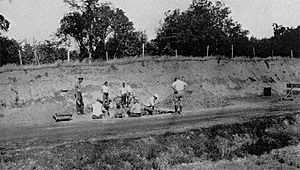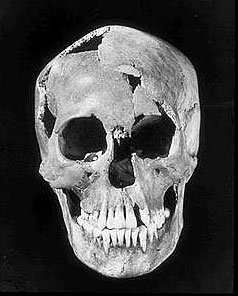Minnesota Woman facts for kids

The Minnesota Woman, also known as the Pelican Rapids-Minnesota Woman, is the skeleton of a young woman. Scientists believe she lived about 8,000 years ago. Her bones were found on June 16, 1931, near Pelican Rapids, Minnesota. Workers were building U.S. Route 59 when they discovered her.
The bones were taken to Dr. Albert Jenks at the University of Minnesota. He studied them and figured out the woman was about 15 or 16 years old. She had never had children. Two special items were found with her: a dagger made from an elk's horn and a pendant made from a conch shell. This type of conch shell, from a snail called Busycon perversum, was only known to live in Florida. This suggests people traveled long distances or traded items back then.
How She Was Found
Road workers found the bones while digging. There were no archaeologists there at first. This made it harder to figure out exactly what happened to the woman.
Scientists believe she was not buried in a special ceremony. There was a thin layer of broken clam or mussel shells over her body. This led to the idea that she might have drowned. Perhaps she fell through ice or out of a boat. Her body might have then been covered by mud at the bottom of a large lake formed by a glacier.
Why Her Discovery Was Important
Before 1926, most scientists thought that people had only lived in America for a few thousand years. The discovery of Minnesota Woman changed this idea. Her bones showed that humans had been in America much, much longer.
Scientists now know she was an early Native American, whose ancestors were Paleo-Indians. Using Radiocarbon dating, a scientific way to find out how old something is, her bones are about 8,000 years old. This time period is known as the beginning of the Archaic period in Minnesota.
The bones of the Minnesota Woman were reburied on October 2, 1999. This was done by Sioux tribes in South Dakota. Because of this, her bones cannot be studied further today.


